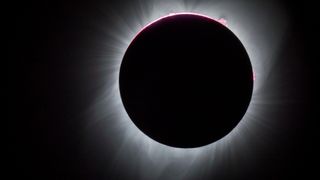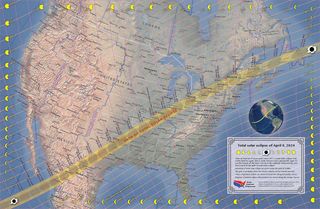
If we were to compare the "Great North American Solar Eclipse" of April 8 against other eclipses over the past century, where would it rank?
Actually, it would end up quite high on the list.
During the last 100 years, from 1925 (inclusive) to 2024, the maximum duration of totality of 75 solar eclipses that we sampled (including annular-total/hybrid and non-central total eclipses) averaged 3 minutes 13 seconds. Incidentally, the absolute maximum possible duration of a total solar eclipse is 7 minutes 32.1 seconds, according to Jean Meeus, a Belgian Earth and planetary scientist specializing in celestial mechanics.
So, when a total solar eclipse attains a duration of over 4 minutes it certainly should be considered as an exceptional eclipse. Our upcoming total solar eclipse on April 8, will achieve a maximum duration of 4 minutes 28.2 seconds in north central Mexico. Among the 75 solar eclipses that we sampled, 29 belong to the "Four Minute or Greater Club" and the April 8 eclipse ranks among the top 25% in terms of duration.
Related: Total solar eclipse 2024: Everything you need to know
100-year comparison
Even more striking are the comparisons among totalities that cross the boundaries of the United States during this 100-year timeframe. These are listed in the table below.
Not including our 2024 eclipse which we kept separate, there are 14 eclipses contained in this particular survey. One of these (April 28, 1930) is a rare "hybrid" or annular-total eclipse, with that part of the eclipse path that produces (albeit an exceedingly brief) total eclipse, passing over parts of five western states.
Get the Space.com Newsletter
Breaking space news, the latest updates on rocket launches, skywatching events and more!
| Date (UTC) | Duration | Altitude (in degrees) | Width of visible region (in miles) | Location in United States |
| Jan. 25, 1925 | 2m 02s | 18° | 107 | Sunrise MN to WI, MI, NY, PA, NJ, MA, CT, RI |
| April 28, 1930 | 0m 01s | 62° | 0.6 | Hybrid; total for CA, NV, OR, ID, MT |
| Aug. 31, 1932 | 1m 40s | 31° | 103 | VT, NH, ME, MA |
| Feb. 4, 1943 | 1m 52s | 10° | 104 | Alaska |
| July 9, 1945 | 0m 31s | 8° | 28 | Sunrise for Idaho to MT |
| June 30, 1954 | 1m 22s | 10° | 74 | Sunrise for Nebraska to SD, IA, MN, WI, MI |
| Oct. 2, 1959 | 0m 56s | 1° | 37 | Sunrise for New Hampshire & Massachusetts |
| July 20, 1963 | 1m 36s | 46° | 62 | Alaska, Maine |
| March 7, 1970 | 3m 10s | 54° | 88 | FL, GA, SC, NC, VA, MA |
| July 10, 1972 | 2m 22s | 38° | 105 | Alaska |
| Feb. 26, 1979 | 2m 46s | 24° | 191 | WA, OR, ID, MT, ND |
| July 22, 1990 | 2m 19s | 34° | 130 | Alaska (Aleutians) |
| July 11, 1991 | 4m 10s | 22° | 139 | Big Island of Hawaii |
| Aug. 21, 2017 | 2m 43s | 64° | 71 | Spanned contiguous US; Oregon to S. Carolina |
| — | — | — | — | — |
| 1924-2024 averages | 1m 58s | 32° | 89 | Row 16 - Cell 4 |
| April 8, 2024 | 4m 27s | 69° | 108 | TX northeast to ME |




In making comparisons of the characteristics of the April 8, 2024 eclipse to the 13 on our list, here is what is found:
Duration: Totality for these 14 United States eclipses averages 1 minute 58 seconds. By this standard seven eclipses are "above average" while only two of the 13 exceed the three-minute mark (March 7, 1970 and July 11, 1991). Excluding the April 8 eclipse, which produces a totality lasting 4 minutes 27 seconds for south Texas, only the 1991 eclipse can boast a duration greater than four minutes.
Maximum altitude: The higher the eclipsed sun is up in the sky, the greater are the chances that it will be free from haze or clouds. The value for the upcoming April 8 event is 69° (in south Texas). The average for the other 14 United States eclipses places the sun less than half as high in the sky at 32°. Four of the 13 have the sun more than halfway up (greater than 45°) in the sky. Note, however, that the second most favorable of the 14, that of April 28, 1930, is the annular-total, with an excellent 62° altitude, coupled with a "totality" of just one second!
Maximum path width: At the time of a total eclipse, the moon's shadow cast on the Earth's surface is in the shape of an ellipse. Just how elliptical the shadow will appear is controlled by the altitude of the sun above the horizon. The average of the 14 United States eclipses gives a path width of 89 miles. The upcoming eclipse of April 8, has a value of 108 miles in this category, but places fourth behind the eclipses of Feb. 26, 1979, July 11, 1991 and July 22, 1990.
In fact, the width of the 1979 eclipse measured 83 miles larger than the 2024 eclipse.

It should be pointed out, however, that in the case of that 1979 eclipse, the sun stood at a maximum altitude of only 24° (in northwest North Dakota, near the town of Portal), with the umbral shadow striking the Earth rather obliquely. Consequently, the projected shape of the umbra on the Earth was a highly elongated oval measuring 83 by 191 miles along and across its path, respectively. Meanwhile, on April 8, over south Texas, the altitude of the totally eclipsed sun will be 69° — almost three times higher compared to 1979. So, rather than an elongated oval, the shape of the moon's shadow in 2024 will be more circular.
Put another way, from North Dakota in 1979, at mid-totality, a person positioned at the center of the eclipse track was no more than 41.5 miles from either the leading or trailing edge of the umbra, On the other hand, on April 8, at mid-totality at the center of the eclipse track in south Texas, an observer will be up to 54 miles from the leading and trailing edges of the umbral shadow.
Region of visibility: Total solar eclipses seem to have a perverse habit of avoiding major population areas. While it is true that a few eclipses in our sample of 14 passed over large metropolitan areas (NYC in 1925; Minneapolis 1954; Boston 1959), for the most part the total viewing audience is composed chiefly of smaller towns and communities. Even for the 1970 eclipse which paralleled the Atlantic seaboard, the shadow completely missed the heavily populated Northeast Corridor. The largest population center that experienced totality was the Norfolk-Portsmouth, VA metropolitan area: 508,000. And the total number of people within the entire totality zone probably numbered less than two million.
In contrast, the total eclipse of August 2017, whose path stretched from coast-to-coast, encompassed a viewing audience of 11 million people. But as impressive as that was, the upcoming April 8 eclipse will pass over many metropolitan areas from Texas to northern New England, giving an estimated 32 million people a chance to witness firsthand this amazing spectacle.
Very likely then, the upcoming eclipse of April 8 will represent the greatest concentration of people ever to be immersed in the moon's dark umbral shadow in the history of the United States!

The distant past ... and the near future: From everything we have noted so far, it becomes obvious that, so far as the United States is concerned, that the eclipse of April 8, 2024 is quite exceptional. In fact, there is only one other event to which we could strike a reasonable comparison. That would be the eclipse of June 16, 1806. On that day, the shadow of the moon swept across North America, crossing through the northern Midwest and continuing through New York State and New England. From the standpoint of duration of totality, this eclipse was the finest for the North American continent during the entire 19th century and would not be rivaled until the mid-21st century.
The total phase of this 1806 eclipse lasted for 4 minutes 53 seconds in the vicinity of Marblehead, Massachusetts (northeast of Boston), with mid-totality occurring with the sun near its highest point in the sky — 70° — just a half hour before local noon.
And it will not be until the total solar eclipse of Aug. 12, 2045, that the contiguous United States will, for the first time, experience a total eclipse of over 6 minutes. The expected maximum duration of totality for this unique event, will be 6 minutes 6 seconds, near Port St. Lucie, Florida; the longest totality in U.S. history. Mark your calendars!
Until then, however, the finest total eclipse of the sun for the United States between the years 1806 and 2045 will be that of April 8, 2024.
Joe Rao serves as an instructor and guest lecturer at New York's Hayden Planetarium. He writes about astronomy for Natural History magazine, the Farmers' Almanac and other publications.
Join our Space Forums to keep talking space on the latest missions, night sky and more! And if you have a news tip, correction or comment, let us know at: community@space.com.

Joe Rao is Space.com's skywatching columnist, as well as a veteran meteorologist and eclipse chaser who also serves as an instructor and guest lecturer at New York's Hayden Planetarium. He writes about astronomy for Natural History magazine, the Farmers' Almanac and other publications. Joe is an 8-time Emmy-nominated meteorologist who served the Putnam Valley region of New York for over 21 years. You can find him on Twitter and YouTube tracking lunar and solar eclipses, meteor showers and more. To find out Joe's latest project, visit him on Twitter.